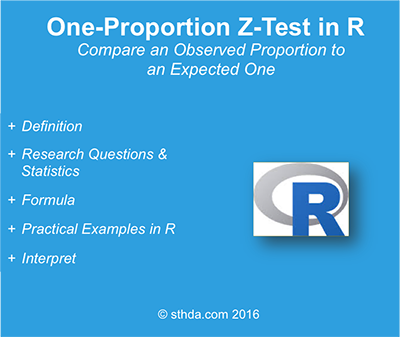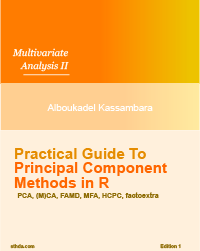One-Proportion Z-Test in R
What is one-proportion Z-test?
For example, we have a population of mice containing half male and have female (p = 0.5 = 50%). Some of these mice (n = 160) have developed a spontaneous cancer, including 95 male and 65 female.
We want to know, whether the cancer affects more male than female?
In this setting:
- the number of successes (male with cancer) is 95
- The observed proportion (\(p_o\)) of male is 95/160
- The observed proportion (\(q\)) of female is \(1 - p_o\)
- The expected proportion (\(p_e\)) of male is 0.5 (50%)
- The number of observations (\(n\)) is 160

Research questions and statistical hypotheses
Typical research questions are:
- whether the observed proportion of male (\(p_o\)) is equal to the expected proportion (\(p_e\))?
- whether the observed proportion of male (\(p_o\)) is less than the expected proportion (\(p_e\))?
- whether the observed proportion of male (\(p\)) is greater than the expected proportion (\(p_e\))?
In statistics, we can define the corresponding null hypothesis (\(H_0\)) as follow:
- \(H_0: p_o = p_e\)
- \(H_0: p_o \leq p_e\)
- \(H_0: p_o \geq p_e\)
The corresponding alternative hypotheses (\(H_a\)) are as follow:
- \(H_a: p_o \ne p_e\) (different)
- \(H_a: p_o > p_e\) (greater)
- \(H_a: p_o < p_e\) (less)
Note that:
- Hypotheses 1) are called two-tailed tests
- Hypotheses 2) and 3) are called one-tailed tests
Formula of the test statistic
The test statistic (also known as z-test) can be calculated as follow:
\[ z = \frac{p_o-p_e}{\sqrt{p_oq/n}} \]
where,
- \(p_o\) is the observed proportion
- \(q = 1-p_o\)
- \(p_e\) is the expected proportion
- \(n\) is the sample size
- if \(|z| < 1.96\), then the difference is not significant at 5%
- if \(|z| \geq 1.96\), then the difference is significant at 5%
- The significance level (p-value) corresponding to the z-statistic can be read in the z-table. We’ll see how to compute it in R.
The confidence interval of \(p_o\) at 95% is defined as follow:
\[ p_o \pm 1.96\sqrt{\frac{p_oq}{n}} \]
Note that, the formula of z-statistic is valid only when sample size (\(n\)) is large enough. \(np_o\) and \(nq\) should be \(\geq\) 5. For example, if \(p_o = 0.1\), then \(n\) should be at least 50.
Compute one proportion z-test in R
R functions: binom.test() & prop.test()
The R functions binom.test() and prop.test() can be used to perform one-proportion test:
- binom.test(): compute exact binomial test. Recommended when sample size is small
- prop.test(): can be used when sample size is large ( N > 30). It uses a normal approximation to binomial
The syntax of the two functions are exactly the same. The simplified format is as follow:
binom.test(x, n, p = 0.5, alternative = "two.sided")
prop.test(x, n, p = NULL, alternative = "two.sided",
correct = TRUE)- x: the number of of successes
- n: the total number of trials
- p: the probability to test against.
- correct: a logical indicating whether Yates’ continuity correction should be applied where possible.
Note that, by default, the function prop.test() used the Yates continuity correction, which is really important if either the expected successes or failures is < 5. If you don’t want the correction, use the additional argument correct = FALSE in prop.test() function. The default value is TRUE. (This option must be set to FALSE to make the test mathematically equivalent to the uncorrected z-test of a proportion.)
Compute one-proportion z-test
We want to know, whether the cancer affects more male than female?
We’ll use the function prop.test()
res <- prop.test(x = 95, n = 160, p = 0.5,
correct = FALSE)
# Printing the results
res
1-sample proportions test without continuity correction
data: 95 out of 160, null probability 0.5
X-squared = 5.625, df = 1, p-value = 0.01771
alternative hypothesis: true p is not equal to 0.5
95 percent confidence interval:
0.5163169 0.6667870
sample estimates:
p
0.59375 The function returns:
- the value of Pearson’s chi-squared test statistic.
- a p-value
- a 95% confidence intervals
- an estimated probability of success (the proportion of male with cancer)
Note that:
- if you want to test whether the proportion of male with cancer is less than 0.5 (one-tailed test), type this:
prop.test(x = 95, n = 160, p = 0.5, correct = FALSE,
alternative = "less")- Or, if you want to test whether the proportion of male with cancer is greater than 0.5 (one-tailed test), type this:
prop.test(x = 95, n = 160, p = 0.5, correct = FALSE,
alternative = "greater")Interpretation of the result
The p-value of the test is 0.01771, which is less than the significance level alpha = 0.05. We can conclude that the proportion of male with cancer is significantly different from 0.5 with a p-value = 0.01771.
Access to the values returned by prop.test()
The result of prop.test() function is a list containing the following components:
- statistic: the number of successes
- parameter: the number of trials
- p.value: the p-value of the test
- conf.int: a confidence interval for the probability of success.
- estimate: the estimated probability of success.
The format of the R code to use for getting these values is as follow:
# printing the p-value
res$p.value[1] 0.01770607# printing the mean
res$estimate p
0.59375 # printing the confidence interval
res$conf.int[1] 0.5163169 0.6667870
attr(,"conf.level")
[1] 0.95See also
Infos
This analysis has been performed using R software (ver. 3.2.4).
Show me some love with the like buttons below... Thank you and please don't forget to share and comment below!!
Montrez-moi un peu d'amour avec les like ci-dessous ... Merci et n'oubliez pas, s'il vous plaît, de partager et de commenter ci-dessous!
Recommended for You!
Recommended for you
This section contains best data science and self-development resources to help you on your path.
Coursera - Online Courses and Specialization
Data science
- Course: Machine Learning: Master the Fundamentals by Standford
- Specialization: Data Science by Johns Hopkins University
- Specialization: Python for Everybody by University of Michigan
- Courses: Build Skills for a Top Job in any Industry by Coursera
- Specialization: Master Machine Learning Fundamentals by University of Washington
- Specialization: Statistics with R by Duke University
- Specialization: Software Development in R by Johns Hopkins University
- Specialization: Genomic Data Science by Johns Hopkins University
Popular Courses Launched in 2020
- Google IT Automation with Python by Google
- AI for Medicine by deeplearning.ai
- Epidemiology in Public Health Practice by Johns Hopkins University
- AWS Fundamentals by Amazon Web Services
Trending Courses
- The Science of Well-Being by Yale University
- Google IT Support Professional by Google
- Python for Everybody by University of Michigan
- IBM Data Science Professional Certificate by IBM
- Business Foundations by University of Pennsylvania
- Introduction to Psychology by Yale University
- Excel Skills for Business by Macquarie University
- Psychological First Aid by Johns Hopkins University
- Graphic Design by Cal Arts
Books - Data Science
Our Books
- Practical Guide to Cluster Analysis in R by A. Kassambara (Datanovia)
- Practical Guide To Principal Component Methods in R by A. Kassambara (Datanovia)
- Machine Learning Essentials: Practical Guide in R by A. Kassambara (Datanovia)
- R Graphics Essentials for Great Data Visualization by A. Kassambara (Datanovia)
- GGPlot2 Essentials for Great Data Visualization in R by A. Kassambara (Datanovia)
- Network Analysis and Visualization in R by A. Kassambara (Datanovia)
- Practical Statistics in R for Comparing Groups: Numerical Variables by A. Kassambara (Datanovia)
- Inter-Rater Reliability Essentials: Practical Guide in R by A. Kassambara (Datanovia)
Others
- R for Data Science: Import, Tidy, Transform, Visualize, and Model Data by Hadley Wickham & Garrett Grolemund
- Hands-On Machine Learning with Scikit-Learn, Keras, and TensorFlow: Concepts, Tools, and Techniques to Build Intelligent Systems by Aurelien Géron
- Practical Statistics for Data Scientists: 50 Essential Concepts by Peter Bruce & Andrew Bruce
- Hands-On Programming with R: Write Your Own Functions And Simulations by Garrett Grolemund & Hadley Wickham
- An Introduction to Statistical Learning: with Applications in R by Gareth James et al.
- Deep Learning with R by François Chollet & J.J. Allaire
- Deep Learning with Python by François Chollet







